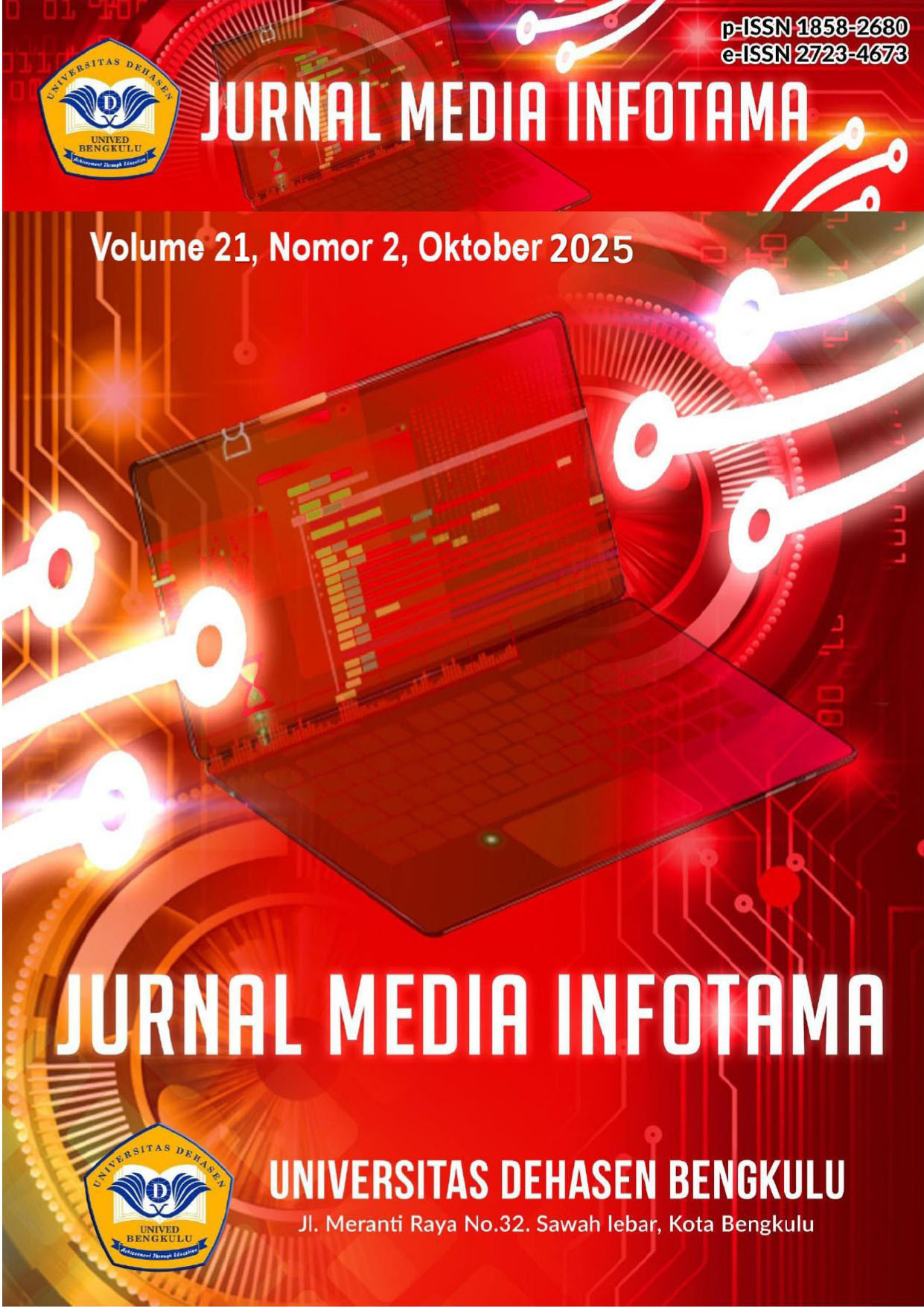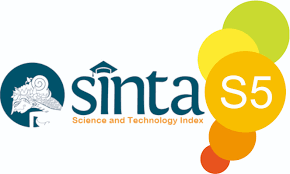Klasifikasi Status Gizi Balita Menggunakan Metode Naive Bayes Di Puskesmas Sawah Lebar Kota Bengkulu
Abstract
Toddler is an abbreviation for babies under five years old, a time when the child's brain experiences rapid growth. Nutrition is actually the most important thing because it is related to human health itself, especially toddlers. In general, toddlers are very vulnerable to nutritional status problems. Therefore, the growth and development of toddlers is an important concern for parents. Classification of nutritional status of toddlers using the Naïve Bayes method at the Sawah Lebar Health Center, Bengkulu City, can help in determining the level of health and make it easier to determine the nutritional status of toddlers so as to provide appropriate and necessary interventions to prevent or overcome nutritional problems in toddlers, and facilitate the classification process to solve problems in large amounts of data using the Naïve Bayes method. Based on testing data in the February Period of 2025, the results obtained are 4 toddlers into the classification of good nutritional status, 3 toddlers into the classification of malnutrition status, and 2 toddlers into the classification of risk of overnutrition. The results of this classification can then be used as a reference for medical personnel at the Bengkulu City Sawah Lebar Health Center to provide appropriate and necessary interventions to prevent or overcome nutritional problems in toddlers.
Downloads
References
[2] Azhari, R., Hartama, D., Lubis, M. R., Nasution, D. F., & Windarto, A. P. (2023). Analisis penerapan data mining terhadap kasus positif Covid-19 menggunakan metode K-Means clustering. J. Informatics, Electr. Electron. Eng, 3(2), 221-235.
[3] Halfiani, S., & Wibowo, A. (2022, September). Klasifikasi Metode Naïve Bayes Untuk Karakteristik Siswa Pada MTSN 32 Jakarta Selatan. In Prosiding Seminar Nasional Mahasiswa Fakultas Teknologi Informasi (SENAFTI) (Vol. 1, No. 1, pp. 667-674).
[4] Herlina, Rusman, A. D. P., Marlina & Suwardoyo, U., 2022. Penerapan Sistem Informasi Berbasis IT Pengolahan Data Rekam Medis Untuk Peningkatan Pelayanan di Rumah Sakit. Pekalongan Jawa Tengah: PT. Nasya Expanding Management ISBN:978-623-423-378-0.
[5] Kadarsih, D. P. (2022). Step By Step Belajar Database MySQL untuk Pemula. Pascal Books.
[6] Lestari, P. I., & Prabowo, K. M. (2024). SISTEM INFORMASI PPID BERBASIS WEBSITE PADA PENGADILAN NEGERI RANGKASBITUNG KELAS II. Jurnal Teknologi Informasi dan Digital, 2(1), 207-216.
[7] Lubis, K., ST, S., & Keb, M. PERANAN GIZI DALAM SIKLUS KEHIDUPAN. GIZI DAN KESEHATAN ANAK BALITA, 22.
[8] Nabeel, M., Majeed, S., Awan, M. J., Muslih-ud-Din, H., Wasique, M., & Nasir, R. (2021). Review on effective disease prediction through data mining techniques. International Journal on Electrical Engineering & Informatics, 13(3).
[9] Normah, N., Nurajizah, S., & Salbinda, A. (2021). Penerapan data mining metode k-means clustering untuk analisa penjualan pada toko fashion hijab Banten. Jurnal Khatulistiwa Informatika, 7(2), 158-163.
[10] Nugrahadi, D. T., Mulyani, T., Kartini, D., Herteno, R., Faisal, M. R., Budiman, I., & Abadi, F. (2023). Efek Transformasi Wavelet Diskrit Pada Klasifikasi Aritmia Dari Data Elektrokardiogram Menggunakan Machine Learning. J. Media, 7, 13-21.
[11] Qolbi, F. N. (2024). RANCANG BANGUN APLIKASI WEB DATA MINING UNTUK ANALISIS POLA PEMBELIAN PRODUK DALAM BISNIS CAFÉ DAN RESTORAN (Studi Kasus: Saung Karuhun) (Doctoral dissertation, Universitas Kuningan).
[12] Setiawan, H. B. & Utama, G. P., 2022. Klasifikasi Status Gizi Balita Menggunakan Metode Naïve Bayes Classifier. Jakarta, Seminar Nasional Mahasiswa Fakultas Teknologi Informasi (SENAFTI) .
[13] Sofiana, M. S. J., Yuliono, A., Warsidah, W., & Safitri, I. (2021). Sosialisasi pemanfaatan pangan hasil laut dan diversifikasi olahannya sebagai usaha menanggulangi stunting pada anak Balita di Kalimantan Barat. Journal of Community Engagement in Health, 4(1), 103-112.
[14] Suprapto, U., 2021. Pemodelan Perangkat Lunak (C3) Kompentesi Keahlian : Rekayasa Perangkat Lunak Untuk SMK/MAK Kelas XI. Jakarta: Grasindo.
[15] Tanty, T., Ginting, B. S., & Simanjuntak, M. (2021). Pengelompokan penyakit pada pasien berdasarkan usia dengan metode K-Means clustering (Studi kasus: Puskesmas Bahorok). ALGORITMA: Jurnal Ilmu Komputer Dan Informatika, 5(2).
[16] Usanto, S. (2023). Penerapan Data Mining Dengan Mengimplementasikan Algoritma K-Means Dalam Proses Clustering Untuk Pengelompokan Mahasiswa Calon Penerima Beasiswa KIP.
[17] Wibowo, D., Novia, M., Rumaksi, R. N., & Gunawan, S. I. (2021). HIGH ACCURACY DETECTION OF COVID-19 BASED ON NAIVE BAYES CLASSIFIER (NBC). In Proceeding of The Symposium on Data Science (SDS) (Vol. 1, pp. 54-61).
[18] Wu, D. (2022). Sistem Aplikasi Dan Manajemen Proyek Penelitian Ilmiah Berbasis Php Dan Mysql. Jurnal Jaringan Interkoneksi
[19] Yendrianof, D. et al., 2022. Analisis dan Perancangan Sistem Informasi. Medan: Yayasan Kita Menulis.
Copyright (c) 2025 Agri Ayu Dewani; Herlina Latipa Sari, Eko Suryana

This work is licensed under a Creative Commons Attribution-ShareAlike 4.0 International License.
An author who publishes in Jurnal Media Infotama agrees to the following terms:The author holds the copyright and grants the journal the right of first publication of the work simultaneously licensed under the Creative Commons Attribution-Share Alike 4.0 License which allows others to share the work with acknowledgment of the work's authorship and initial publication in this journal.Submission of a manuscript implies that the submitted work has not been previously published (except as part of a thesis or report, or abstract); that it is not being considered for publication elsewhere; that its publication has been approved by all co-authors. If and when a manuscript is accepted for publication, the author retains the copyright and retains the publishing rights without limitation.
For new inventions, authors are advised to administer the patent before publication. The license type is CC-BY-SA 4.0.
MEDIA INFORMATION REVIEW: Journal of the Faculty of Computer Science is licensed under a Creative Commons Attribution-ShareAlike 4.0 International License.You are free to:Share
— copy and redistribute material in any medium or formatAdapt
— remix, modify and develop materialfor any purpose, even commercial.
The licensor cannot revoke this freedom as long as you follow the license terms












.png)


